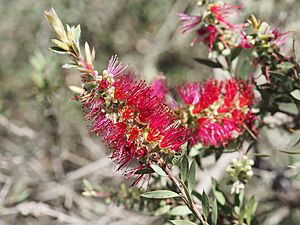Melaleuca williamsii facts for kids
Quick facts for kids Melaleuca williamsii |
|
|---|---|
 |
|
| M. williamsii subsp. williamsii growing near Hillgrove | |
| Conservation status | |
| Scientific classification | |
| Genus: |
Melaleuca
|
| Species: |
williamsii
|
| Synonyms | |
|
Callistemon pungens Lumley & R.D.Spencer |
|
Melaleuca williamsii is a cool plant that belongs to the myrtle family, called Myrtaceae. It grows only in a specific area of Australia, found between north-eastern New South Wales and south-eastern Queensland. This plant is a unique shrub with stiff branches and new leaves that look silvery. Its leaves are a bit prickly, and it grows spikes of pretty purple flowers in late spring. Because it's so special and doesn't grow everywhere, it's listed as a vulnerable species by the Australian Government. This means it needs protection to make sure it doesn't disappear.
Contents
What Melaleuca williamsii Looks Like
Melaleuca williamsii is a shrub that can grow up to 2.5 m (8 ft) tall. That's about as tall as a basketball hoop! It has strong, stiff branches. When new parts of the plant grow, they are covered in soft, silky hairs, which makes them look shiny and silver.
Leaves and Flowers
The leaves of this plant are arranged one after another along the stem. They are usually 18–68 mm (0.7–3 in) long and 3–14 mm (0.1–0.6 in) wide. Their shape can be narrow and oval or like a narrow egg. The leaves can be flat or slightly curved like a half-moon. Each leaf has a sharp tip that is about 1–2 mm (0.04–0.08 in) long. You can also see tiny oil glands on both sides of the leaves.
The flowers of Melaleuca williamsii are often deep red, white, or various shades of pink to purple. They grow in spikes at the ends of the branches. These spikes are quite big, about 25–45 mm (1–2 in) across and 50–60 mm (2.0–2.4 in) long. Each spike can have anywhere from 10 to 65 individual flowers! The petals are small, about 2.1–5.8 mm (0.08–0.2 in) long, and they fall off as the flower gets older. Each flower has many stamens (the parts that hold pollen), usually between 25 and 66 of them.
When it Flowers and Fruits
This plant usually flowers from October to December. After the flowers bloom, they turn into woody fruits. These fruits are called capsules and are about 3.9–6.6 mm (0.2–0.3 in) long.
How Melaleuca williamsii Got its Name
The plant Melaleuca williamsii was first given its current name in 2009 by a scientist named Lyndley Craven. Before that, it was known by a different name, Callistemon pungens. That name was first officially written down in 1990 by Roger Spencer and Peter Lumley. They studied plant material collected near Hillgrove.
The second part of the plant's name, williamsii, is a special way to honor someone. It honors John Beaumont Williams, who was a botanist. A botanist is a scientist who studies plants. John Beaumont Williams was an expert on the plants found in the Northern Tablelands area of New South Wales.
Different Types of Melaleuca williamsii
There are three slightly different types, or subspecies, of Melaleuca williamsii:
- Melaleuca williamsii subsp. fletcheri: This type has stamens that can be up to 19 millimetres (0.7 in) long. Its flower spikes are 30–45 millimetres (1–2 in) wide, and the stamens are pink or mauve. You can find this subspecies in the Stanthorpe area of Queensland.
- Melaleuca williamsii subsp. synoriensis: This type has shorter stamens, up to 11 millimetres (0.4 in) long. Its flower spikes are 25–30 millimetres (0.98–1.2 in) wide. It grows in the Gibraltar Range and Point Lookout areas in New South Wales.
- Melaleuca williamsii subsp. williamsii: This type also has stamens up to 19 millimetres (0.7 in) long, and its flower spikes are 30–45 millimetres (1–2 in) wide. The stamens can be red, crimson, or purple. This subspecies is found in the Northern Tablelands region of New South Wales.
Where Melaleuca williamsii Lives
This special melaleuca plant grows in the higher, cooler areas of north-eastern New South Wales and south-eastern Queensland. It likes to grow in cracks in granite and trachyte rocks, often in forests or open heathland. You can also find it growing in sandy soil or shallow, rocky soil.
Protecting Melaleuca williamsii
Melaleuca williamsii is listed as a "vulnerable" species. This means that its population is decreasing, and it could be at risk of disappearing if we don't protect it. Both the NSW Government Department of Environment and Heritage and the Australian Government Department of the Environment have classified it this way. Efforts are being made to help this unique plant survive and thrive.
Images for kids
-
M. williamsii in the Royal Botanical Garden of Madrid





